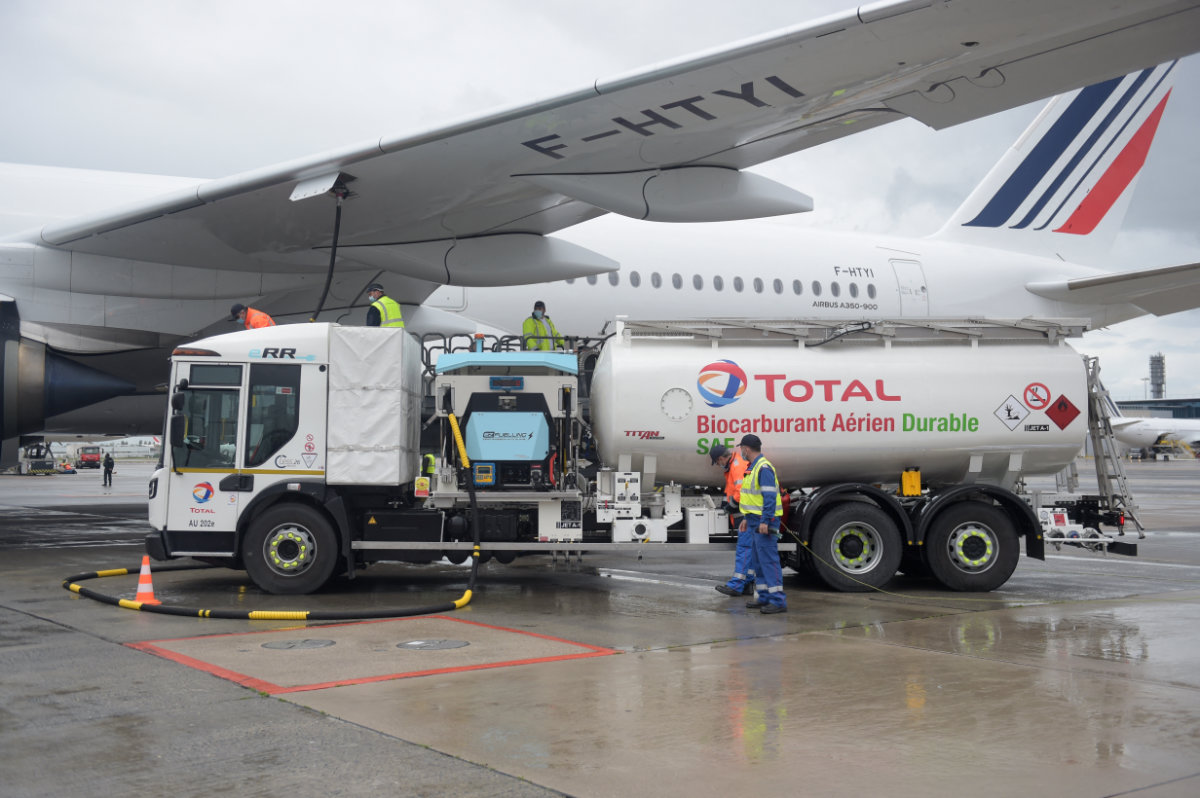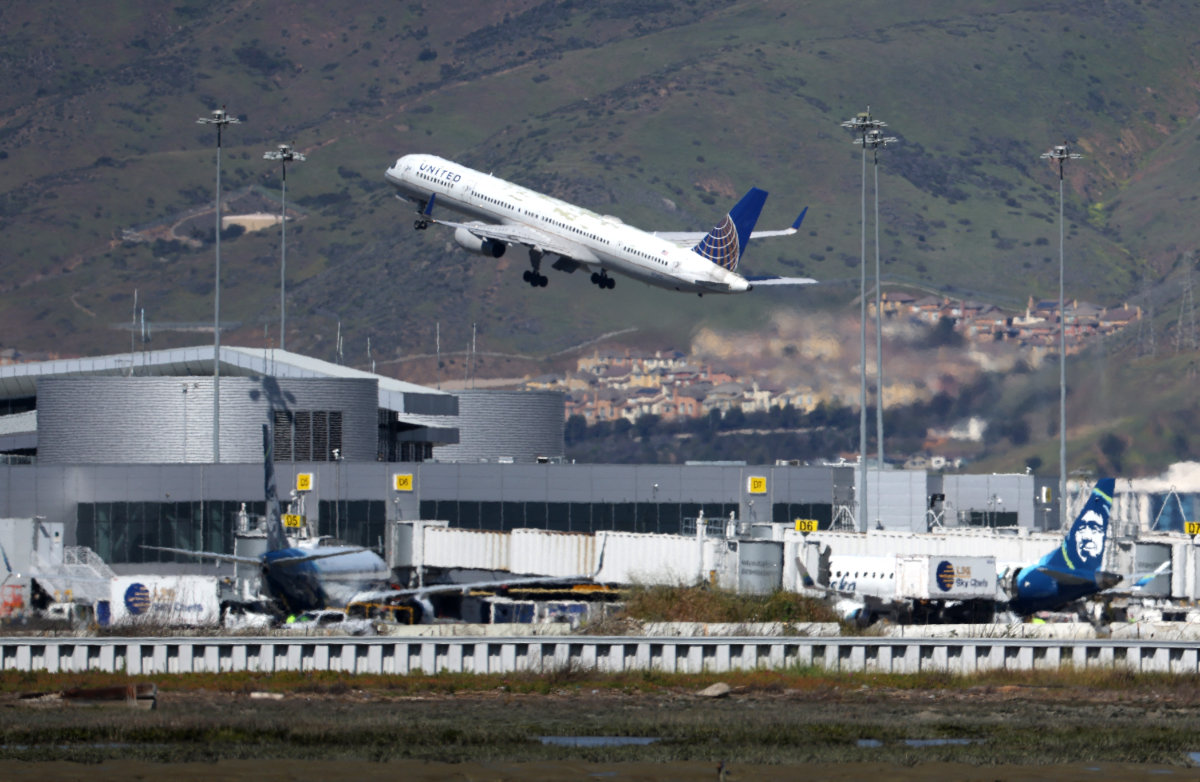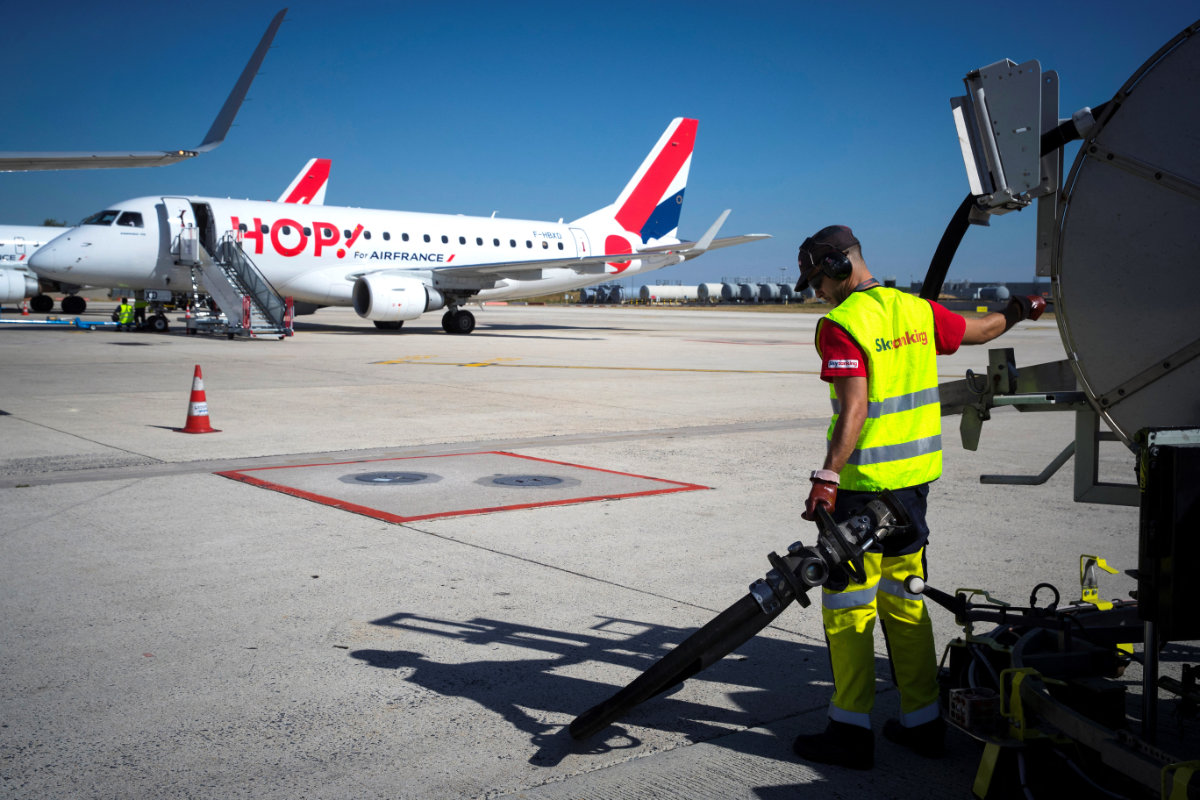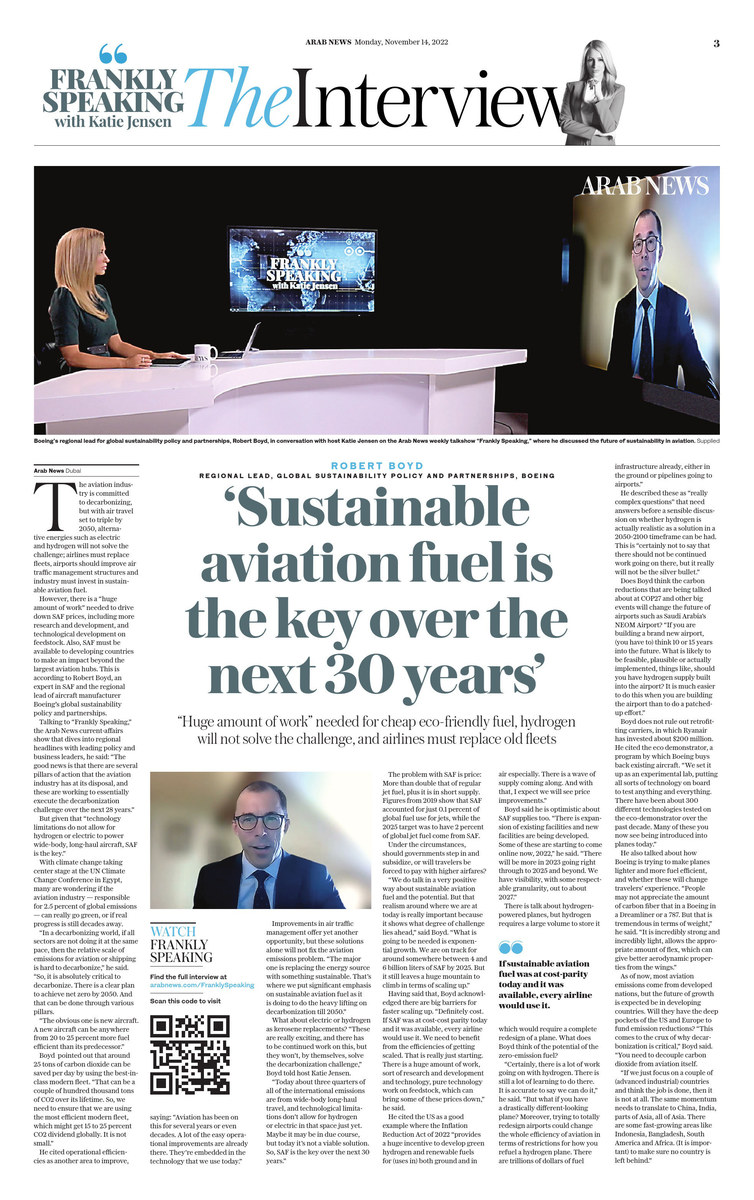DUBAI: The aviation industry is committed to decarbonizing, but with air travel set to triple by 2050, alternative energies such as electric and hydrogen will not solve the challenge; airlines must replace old fleets, airports should improve air traffic management structures and industry must invest in sustainable aviation fuel.
However, there is a “huge amount of work” needed to drive down SAF prices, including more research and development, and technological development on feedstock. Also, SAF must be available to developing countries to make an impact beyond the largest aviation hubs. This is according to Robert Boyd, an expert in SAF and the regional lead of aircraft manufacturer Boeing’s global sustainability policy and partnerships.
Appearing on “Frankly Speaking,” the Arab News weekly current-affairs talkshow that dives deep into regional headlines and speaks with leading policy makers and business leaders, he said: “The good news is that there are several pillars of action that the aviation industry has at its disposal, and these are working to essentially execute the decarbonization challenge over the next 28 years.”

Boeing executive Robert Boyd being interviewed by Katie Jensen on Frankly Speaking.
But given that “technology limitations do not allow for hydrogen or electric to power wide-body, long-haul aircraft, SAF is the key.”
With climate change taking center stage at the UN Climate Change Conference in Egypt, many people are wondering whether the aviation industry — currently responsible for 2.5 percent of global emissions — can really go green, or if real progress is still decades away.
“In a decarbonizing world, if all sectors are not doing it at the same pace, then the relative scale of emissions for aviation or shipping makes it hard to decarbonize,” he said. “So, it is absolutely critical to decarbonize. There is a clear plan to achieve net zero by 2050. And that can be done through various pillars.
“The obvious one is new aircraft. A new aircraft can be anywhere from 20 to 25 percent more fuel efficient than its predecessor.”
Boyd called them “significant numbers,” pointing out that something like 25 tons of carbon dioxide can be saved per day saved by using the best-in-class modern fleet. “That can be a couple of hundred thousand tons of CO2 over its lifetime. So, we need to ensure that we are using the most efficient modern fleet, which might get 15 to 25 percent CO2 dividend globally. It is not small.”

An Airbus A350-900 is refueled with sustainable aviation fuel produced by French energy group Total at France's Roissy airport on May 18, 2021. (AFP file)
He cited operational efficiencies as another opportunity for improvement. “Aviation has been on this for several years or even decades. A lot of the easy operational improvements are already there. They’re embedded in the technology that we use today,” he said.
Improvements in air traffic management offer yet another opportunity, but these solutions have limitations, according to Boyd, will not fix the aviation emissions problem. “The major one is replacing the energy source with something sustainable. That’s where we put significant emphasis on sustainable aviation fuel as it is doing to do the heavy lifting on decarbonization till 2050.”
What about ideas of electric or hydrogen as a potential replacement for kerosene? “These are really exciting, and there has to be continued work on this, but they won’t, by themselves, solve the decarbonization challenge,” Boyd told “Frankly Speaking” host Katie Jensen.
“Today about three quarters of all of the international emissions are from wide-body long-haul travel, and technological limitations don’t allow for hydrogen or electric in that space just yet. Maybe it may be in due course, but today it’s not a viable solution. So, SAF is the key over the next 30 years.”
The problem with SAF is of course the price: More than double the price of regular jet fuel, plus it is in short supply. Figures from 2019 show that SAF accounted for just 0.1 percent of global fuel use for jets, while the 2025 target was to have 2 percent of global jet fuel come from SAF.

Surging jet fuel prices have hampered airline efforts to rebound from two years of the COVID-19 pandemic. The cost of sustainable aviation fuel is currently double that of regular jet fuel. (AFP)
Under the circumstances, should governments step in and subsidize, or will travelers be forced to pay with higher airfares?
“We do talk in a very positive way about sustainable aviation fuel and the potential. But that realism around where we are at today is really important because it shows what degree of challenge lies ahead,” said Boyd. “What is going to be needed is exponential growth. We are on track for around somewhere between 4 and 6 billion liters of SAF by 2025. But it still leaves a huge mountain to climb in terms of scaling up.”
Having said that, Boyd acknowledged there are big barriers to scaling up faster. “Definitely cost. If SAF was at cost-cost parity today and it was available, every airline would use it. We need to benefit from the efficiencies of getting scaled. That is really just starting. There is a huge amount of work, sort of research and development and technology, pure technology work on feedstock, which can bring some of these prices down,” he said.
He cited the US as a good example where the Inflation Reduction Act of 2022 “provides a huge incentive to develop green hydrogen and renewable fuels for (uses in) both ground and in air especially. There is a wave of supply coming along. And with that, I expect we will see price improvements.”

A Hop (Air-France low cost company) plane is refueled at Roissy-Charles de Gaulle Airport, north of Paris, on August 6, 2018. (AFP file)
Boyd said he is optimistic about SAF supplies too. “There is expansion of existing facilities and new facilities are being developed. Some of these are starting to come online now, 2022,” he said. “There will be more in 2023 going right through to 2025 and beyond. We have visibility, with some respectable granularity, out to about 2027.”
There is talk about hydrogen-powered planes, but hydrogen requires a large volume to store it which would require a complete redesign of a plane. What does Boyd think of the potential of the zero-emission fuel?
“Certainly, there is a lot of work going on with hydrogen. There is still a lot of learning to do there. It is accurate to say we can do it,” he said. “But what if you have a drastically different-looking plane? Moreover, trying to totally redesign airports could change the whole efficiency of aviation in terms of restrictions for how you refuel a hydrogen plane. There are trillions of dollars of fuel infrastructure already, either in the ground or pipelines going to airports.”
He described these as “really complex questions” that need answers before you can have a sort of a sensible discussion on whether hydrogen is actually realistic as a solution for aviation in a 2050-2100 timeframe. This is “certainly not to say that there should not be continued work going on there, but it really will not be the silver bullet.”
Does Boyd think the carbon reductions that are being talked about COP27 and other big events will change the future of airports such as Saudi Arabia’s NEOM Airport? “If you are building a brand new airport, (you have to) think 10 or 15 years into the future. What is likely to be feasible, plausible or actually implemented, things like, should you have hydrogen supply built into the airport? It is much easier to do this when you are building the airport than to do a patched-up effort.”
Boyd does not rule out the idea of retrofitting carriers, something in which Ryanair has invested about $200 million. He cited the example of the eco demonstrator, a program by which Boeing buys back an existing aircraft from an operator. “We set it up as an experimental lab, putting all sorts of technology on board to test anything and everything. There have been about 300 different technologies tested on the eco-demonstrator over the past decade. Many of these you now see being introduced into planes today.”
He also talked about how Boeing is trying to make planes lighter and more fuel efficient, and whether these will change travelers’ experience. “People may not appreciate the amount of carbon fiber that in a Boeing in a Dreamliner or a 787. But that is tremendous in terms of weight,” he said. “It is incredibly strong and incredibly light, allows the appropriate amount of flex, which can give better aerodynamic properties from the wings.”
As of now, most of the aviation emissions are coming from developed nations, but the future of growth is expected be in developing countries. Will they have the deep pockets of nations like the US and Europe to fund emission reductions? “This comes to the crux of why decarbonization is critical,” Boyd said. “You need to decouple carbon dioxide from aviation itself.
“If we just focus on a couple of (advanced industrial) countries and think the job is done, then it is not at all. The same momentum needs to translate to China, India, parts of Asia, all of Asia. There are some fast-growing areas like Indonesia, Bangladesh, South America and Africa. (It is important) to make sure no country is left behind.”













